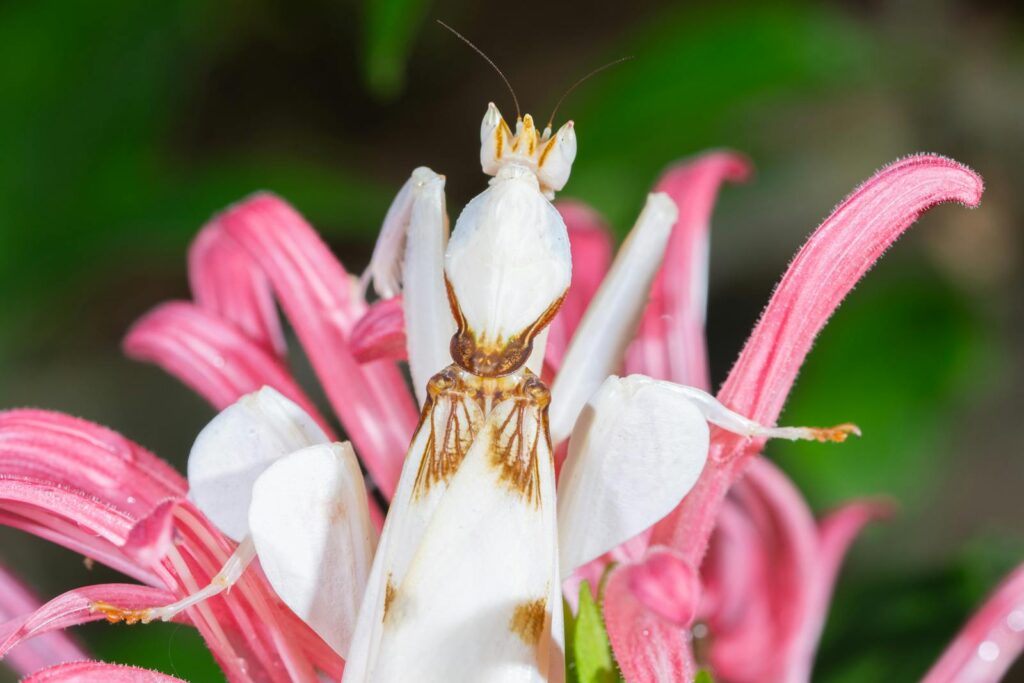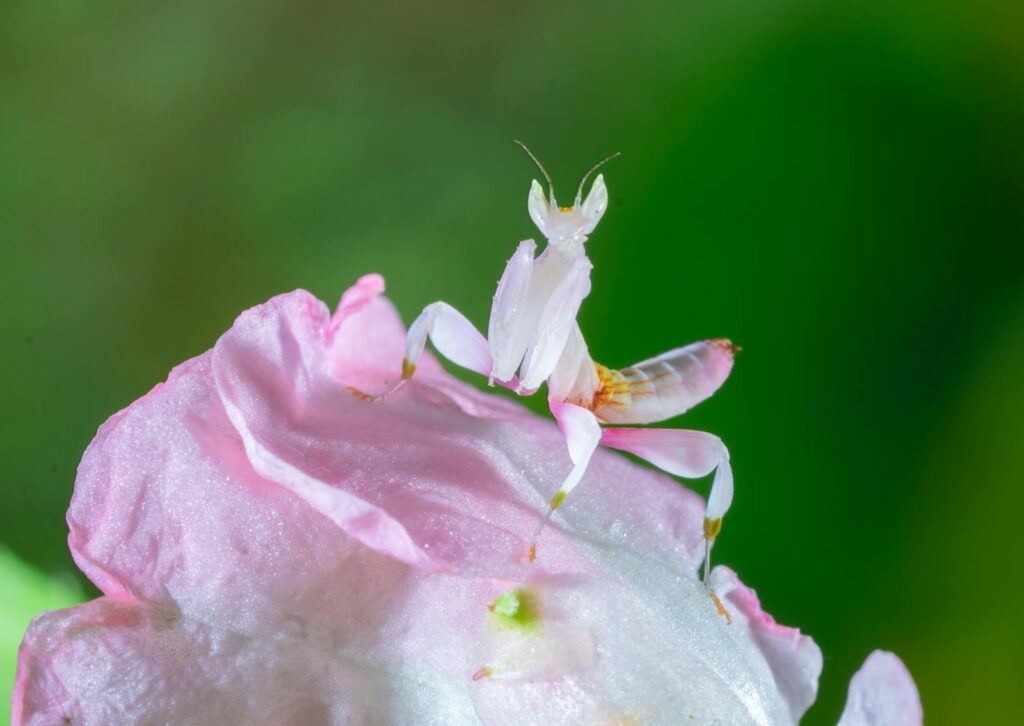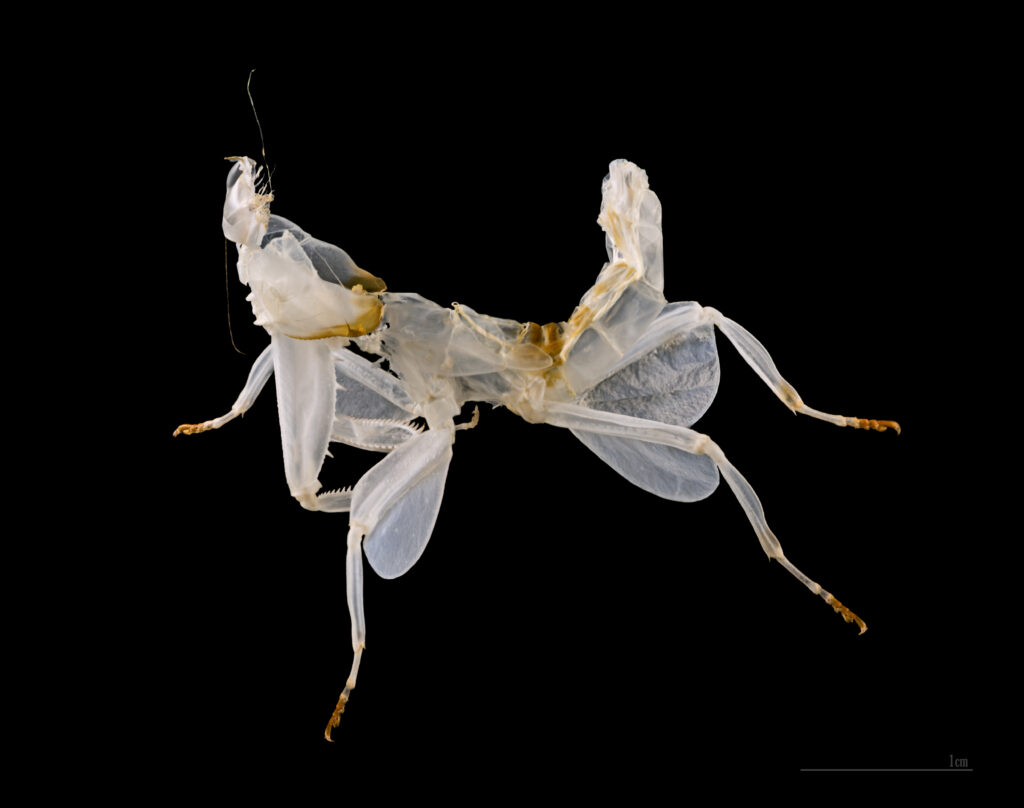In the remarkable world of evolutionary adaptations, few examples are as visually striking and functionally ingenious as the orchid mantis. This extraordinary insect has developed one of nature’s most sophisticated forms of mimicry, transforming its body to resemble a flower so convincingly that it attracts the very prey it seeks to capture. Unlike traditional camouflage that helps creatures blend into their surroundings to avoid detection, the orchid mantis employs aggressive mimicry—a deceptive strategy that lures unsuspecting pollinators to their demise. This fascinating predator stands as a testament to the incredible adaptability of life and the complex relationship between form and function in the natural world.
The Magnificent Orchid Mantis: An Overview

The orchid mantis (Hymenopus coronatus) is a remarkable species of praying mantis native to the rainforests of Southeast Asia, particularly Malaysia, Indonesia, and Thailand. Unlike typical green mantises that blend with foliage, this species has evolved to mimic the appearance of tropical flowers with astonishing precision. Their bodies feature elaborate petal-like extensions and coloration ranging from white to pink, creating an uncanny resemblance to orchid flowers. What makes these insects truly extraordinary is that they don’t simply hide among flowers—they become the flower, positioning themselves on vegetation where pollinators would naturally expect to find blooms. This sophisticated form of mimicry represents one of the most specialized predatory adaptations in the insect world.
The Evolution of Floral Mimicry

The evolution of the orchid mantis’s floral mimicry represents a fascinating case of convergent evolution, where natural selection has shaped the insect to resemble flowers independently of any shared ancestry with plants. This adaptation likely developed over millions of years as mantises with even slightly flower-like appearances gained hunting advantages over their peers. Scientists believe that the original adaptation may have been simple crypsis (hiding from predators), which later evolved into the more complex aggressive mimicry we see today. The selective pressure of increased prey capture success would have continuously refined this mimicry, resulting in increasingly precise resemblances to actual flowers. Interestingly, the orchid mantis doesn’t mimic one specific orchid species but rather embodies the general characteristics that make flowers attractive to pollinators, creating what researchers call an “idealized” flower appearance.
Physical Characteristics That Enable Deception

The orchid mantis possesses several specialized physical adaptations that create its convincing floral disguise. Most notably, its four walking legs have evolved broad, flat, petal-like extensions called lobes, which are typically white or pink and feature slightly jagged edges resembling flower petals. The mantis’s body is unusually flattened and widened compared to other mantis species, creating a shape that mimics a flower’s corolla. Its exoskeleton features a specialized texture and coloration that gives it a convincing petal-like appearance, complete with a slight translucency at the edges that mimics the delicate nature of actual flower petals. Perhaps most remarkably, the orchid mantis’s body often exhibits ultraviolet patterns invisible to humans but visible to insects, potentially mimicking the nectar guides that flowers use to attract pollinators to their centers—precisely where the mantis’s grasping forelegs await unsuspecting prey.
A Master of Color-Changing Abilities

One of the orchid mantis’s most impressive abilities is its capacity to adjust its coloration to match its surroundings and optimize its hunting strategy. Young orchid mantises are typically bright pink, while adults often display more subtle white to pink hues that can be adjusted based on environmental conditions. This color change isn’t instantaneous like that of an octopus or chameleon but occurs gradually over days through a process of pigment redistribution within specialized cells called chromatophores. The mantis can shift between white, pink, and variations of these colors depending on the flowering plants in its vicinity, maximizing its attractiveness to pollinators. Interestingly, research suggests that orchid mantises may actively select hunting locations based on the compatibility of their current coloration with the surrounding flowers, demonstrating a sophisticated awareness of their own camouflage effectiveness.
The Perfect Hunting Strategy

The orchid mantis employs an extraordinary sit-and-wait hunting strategy that turns the tables on traditional predator-prey dynamics. Rather than actively pursuing prey, it positions itself on stems or leaves where flowers would typically be found and remains motionless, often gently swaying as if being moved by a breeze. This strategy is known as aggressive mimicry—unlike defensive camouflage, the mantis isn’t trying to hide but rather to actively attract prey by appearing to be something desirable. When flying insects such as butterflies, bees, or flies approach to feed on what they perceive as a nectar-rich flower, the mantis strikes with its specialized forelegs at remarkable speed—typically in less than 1/20th of a second, too fast for the human eye to follow. The success of this hunting method is so effective that studies show orchid mantises can sometimes attract more pollinators than actual flowers in their vicinity.
Scientific Studies Confirming the Deception

For many years, the orchid mantis’s floral mimicry was accepted as fact based on observation alone, but recent scientific studies have provided empirical evidence confirming this remarkable adaptation. In groundbreaking research published in 2014, scientists from Macquarie University in Australia experimentally demonstrated that the orchid mantis doesn’t just resemble flowers—it actively attracts the same pollinators that visit flowers. The researchers conducted field experiments in Malaysia, where they placed orchid mantises in natural environments and observed that flying insects approached and attempted to land on the mantises at a rate comparable to actual flowers. Further analysis using spectrophotometry confirmed that the mantis’s color pattern is perceptually similar to real flowers from the visual perspective of insect pollinators. Perhaps most remarkably, the research showed that the mantis doesn’t mimic a specific flower species but rather embodies an “idealized” flower form that is highly attractive to a variety of pollinating insects.
Beyond Simple Mimicry: The Allure Factor

What makes the orchid mantis’s deception truly extraordinary is that it doesn’t merely resemble flowers—it can actually be more attractive to certain pollinators than real flowers in its habitat. Research has revealed that the mantis exhibits what scientists call “sensory exploitation,” where it has evolved features that trigger particularly strong attraction responses in the sensory systems of its prey. The mantis’s bright coloration, symmetrical form, and distinct contrast against green foliage create a supernormal stimulus—essentially a hyper-attractive version of a flower that pollinators find irresistible. This phenomenon explains why insects will sometimes bypass actual flowers to investigate the mantis, despite the mortal danger. The effectiveness of this strategy suggests that the orchid mantis has evolved to exploit innate preferences in insect visual systems, creating an appearance that appeals to the broadest possible range of potential prey rather than mimicking a single flower species perfectly.
Lifecycle and Reproduction

The lifecycle of the orchid mantis begins with an ootheca—a specialized egg case produced by the female that typically contains 40-60 eggs protected by a hardened foam-like substance. After approximately 6-8 weeks of incubation, the nymphs emerge as miniature versions of adults, already displaying their characteristic flower-like appearance, albeit with less developed petal-like extensions. These young mantises undergo several molts as they grow, with each successive stage (instar) showing increasingly pronounced floral mimicry features. Sexual dimorphism becomes apparent as they mature, with females growing significantly larger (reaching about 2.5 inches or 6-7 cm) while males remain smaller and less flower-like. After reaching adulthood, females can live for 8-10 months, while males typically have shorter lifespans of 6-8 months. Like many mantis species, mating can be a dangerous affair for males, who risk being consumed by their mates during or after copulation—a behavior that may provide nutritional benefits for egg production.
Habitat and Distribution

The orchid mantis is primarily found in the tropical rainforests of Southeast Asia, with populations documented across Malaysia, Indonesia, Thailand, Philippines, and parts of Myanmar. These insects typically inhabit the understory and middle layers of rainforests where flowering plants are abundant and pollinators are active. Within these ecosystems, they position themselves strategically among vegetation at heights where flying insects are likely to be searching for flowers. The specific microhabitats preferred by orchid mantises often feature flowering plants from families like Orchidaceae, Zingiberaceae (gingers), and various other colorful tropical blooms that attract similar pollinators. Climate change and habitat destruction pose significant threats to these specialized predators, as they require specific environmental conditions and intact rainforest ecosystems to thrive. Conservation efforts focusing on preserving Southeast Asian rainforests inadvertently protect this remarkable species and the complex ecological relationships it represents.
Other Noteworthy Flower Mimics in Nature

While the orchid mantis may be the most famous flower mimic, it is far from the only example of this evolutionary strategy in nature. The Malaysian orchid mantis (Theopropus elegans), a close relative of Hymenopus coronatus, displays similar but distinct floral mimicry, often with more muted coloration. In the spider world, the magnificent flower crab spiders (Thomisidae family) can change color between white and yellow to match the flowers they hunt from, creating a similar ambush strategy. Some orchid species have evolved in the opposite direction, developing flowers that mimic female insects to attract male pollinators—a strategy exemplified by the bee orchid (Ophrys apifera). Even within the insect world, certain katydids and beetles have evolved floral appearances for similar predatory advantages or protective camouflage. These diverse examples of convergent evolution demonstrate how the selective pressure of predator-prey relationships has repeatedly driven the development of floral mimicry across entirely different branches of the evolutionary tree.
Cultural Significance and Human Fascination

The orchid mantis has captivated human imagination across cultures due to its extraordinary beauty and deceptive hunting strategy. In parts of Southeast Asia where it naturally occurs, the insect often appears in traditional folklore as a symbol of cunning beauty and the duality of nature. Among entomology enthusiasts worldwide, the orchid mantis has achieved almost legendary status, with specimens being highly sought after for observation and photography. The species has inspired numerous nature documentaries, scientific studies, and even biomimetic engineering projects attempting to replicate its specialized adaptations. In recent years, social media has amplified fascination with this creature, with viral videos and photographs spreading awareness of this remarkable evolutionary achievement to millions. The orchid mantis serves as a powerful ambassador for insect conservation, demonstrating that invertebrates can be just as charismatic and worthy of protection as more traditionally celebrated mammals and birds.
Conservation Status and Threats

Despite its popularity among entomology enthusiasts, the orchid mantis faces significant conservation challenges that threaten its future in the wild. The species has not been formally assessed by the IUCN Red List, creating a significant gap in our understanding of its conservation status across its range. Habitat destruction poses the most immediate threat, with Southeast Asian rainforests being cleared at alarming rates for palm oil plantations, logging, and agricultural expansion. The specialized nature of the orchid mantis’s hunting strategy makes it particularly vulnerable to ecosystem disruption, as it depends on healthy populations of flowering plants and the pollinators they attract. Additionally, the exotic pet trade has created demand for wild-caught specimens, potentially putting pressure on natural populations in accessible areas. Climate change represents a longer-term threat, as rising temperatures and altered precipitation patterns could disrupt the delicate synchronization between the mantis, flowering plants, and pollinator activity that has evolved over millions of years.
Conclusion: Nature’s Masterpiece of Deception

The orchid mantis stands as one of nature’s most extraordinary examples of evolutionary adaptation, blurring the line between hunter and habitat in a way that continues to fascinate scientists and nature enthusiasts alike. This remarkable insect demonstrates not just the power of natural selection to create seemingly impossible biological designs, but also the complex interconnectedness of species within ecosystems. Through its specialized form of aggressive mimicry, the orchid mantis reveals how perception, deception, and adaptation intertwine in the ongoing evolutionary arms race between predator and prey. As researchers continue to study this masterpiece of natural engineering, we gain deeper insights into the evolutionary processes that have shaped life on Earth. The orchid mantis reminds us that sometimes the most extraordinary biological innovations can be found in the smallest creatures, if only we take the time to look closely enough at the remarkable diversity of life that surrounds us.

